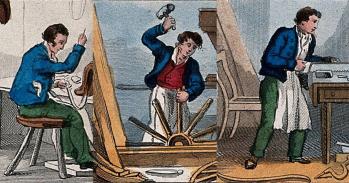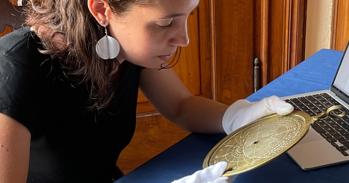
Dr Hannah Newton, an historian of science with an interest in how previous generations coped with childhood illness, digs up some 17th century tips for making medicine taste better and finds evidence for common sense and compassion among the doctors of the day.
Dr Hannah Newton, an historian of science with an interest in how previous generations coped with childhood illness, digs up some 17th century tips for making medicine taste better and finds evidence for common sense and compassion among the doctors of the day.
Practitioners tried to overcome problems of taste by using distraction. The French midwifery expert François Mauriceau suggested that infants suffering from painful teething should be given ‘a Silver Coral, furnish’d with small Bells, to divert the Child’.
Hannah Newton
Doctors and parents know from experience that it can be difficult persuading a child to take medicine. Averse to bitter tastes, young patients often refuse or spit out their medicines. Julie Mennella, a scientist at the Monell Chemical Senses Center in Pennsylvania, has warned that children’s non-compliance is a ‘public health priority’, and in some instances may impede recovery from illness, or even be life-threatening. Help may be at hand, however: scientists at the 241st National Meeting of the American Chemical Society have launched a new compound that inhibits the tongue’s of perception of bitter tastes, nicknamed the ‘bitter blocker GIV3616’. This sophisticated substance may come to replace Mary Poppins’ method of adding a spoonful of sugar to disguise bitter tastes. Is this really necessary though? History offers some cheaper, though less high-tech alternatives. My research on children’s medicine in the seventeenth century reveals that physicians and parents at this time devised an assortment of imaginative strategies to make medicines ‘grateful & pleasing to the Sick Child, & such as…trouble not its Pallate’.
It is a common misconception that children’s preference for sweet over bitter flavours is a modern phenomenon, a consequence of the targeted marketing of sugary foods and drinks at the young. Recently, however, scientists have asserted that children’s predilections are ‘a reflection of their basic biology’, evolved for their survival. Specialised taste cells – the taste buds – appear in the fetus at 7 weeks gestation. Within hours of birth, infants reject bitter tastes and prefer sweet ones, according to Mennella. The reason is simple: bitterness, like pain, is nature’s warning, a sign of the potential harm that might ensue if the substance is ingested. Sweet foods, on the other hand, are usually safe, and they tend to be rich sources of energy for the growing child. Children’s tastes seem to have changed little over the centuries. The Sussex doctor John Pechey wrote in 1697, ‘sweet things which Children eat, and are delighted with…[they] eat greedily’, while a physician from Kent, Robert Pemell, noted in 1653 that children ‘will hardly take’ anything that is ‘so bitter’. These doctors attributed children’s penchants to the heightened sensitivity of the ‘teats’ of their tongues – the taste buds.
One popular seventeenth-century method for making medicines palatable was to substitute unpleasant ingredients with substances of a more agreeable flavour. When treating children for threadworms, Dr Pemell advised giving children ‘juyce of Lemons or Citrons’ in place of the bitter herb wormwood. Where the use of disagreeable ingredients was unavoidable, practitioners tried to disguise the taste by putting the medicine into the child’s normal food or drink. The Dutch physician Franciscus Sylvius declared, ‘Knowing that children are nice [fussy], and can scarce be prevailed with to take even the smallest . . . doses’ of bitter medicines, he suggested that ‘these may be given in their milk or drink, they may be [the] better beguiled; scarce discerning them’. Medicines could be mixed with mashed apple, or in the case of babies, breast milk. In addition to disguising the noxious taste, practitioners suggested giving pleasant drinks after the child had taken the medicine, to counter any lingering bad taste. In the 1680s, Thomas Davies fed his child ‘a little beere posset drink…to take away the ill taste’ of a remedy containing castor oil and piony. This adaptation might raise eyebrows today, but weak beer was a standard drink for children in the seventeenth century.
Another way to make medicine tasty was to ‘give it sweetned with Sugar’. The historian Joan Thirsk has shown that although honey was the ‘traditional sweetener’, by the 1650s, sugar was becoming more fashionable, because it was regarded as a healthier food. In 1651, the physician Francis Glisson advised adding ‘some pleasant and agreable Liquor, or . . . candid Cherries’ to his medicine on the grounds that the child ‘delights . . . in such things’. Laypeople also sweetened children’s medicines. In 1660, Abigail Harley gave her young niece ‘a drink of maidenhaire & violet leaves & hyslop’ which she had ‘swetened . . . with syrop of violets & sugar candy’. As well as seeking to improve the taste, some parents sought to ameliorate the smell. Sarah Hughes’ recipe for ‘A purge for Children’, dated 1637, had to be tempered with ‘soe much of cinnamon water as will mend the smell’.
Practitioners tried to overcome problems of taste by using distraction. The French midwifery expert François Mauriceau suggested that infants suffering from painful teething should be given ‘a Silver Coral, furnish’d with small Bells, to divert the Child’. When it came to treating older children, parents and doctors used a mixture of reasoned argument and praise to persuade young patients to take their medicines. In 1733, the MP John Campbell wrote to his six-year-old son Pryce to commend him for ‘being so good in takeing what the Dr order’d you’. He added, ‘now you see it has done you so much good I hope you will never be unwilling to take what is thought necessary to make you well’. Parents in this period had high expectations of their children, believing them capable of understanding the necessity of taking an unpleasant treatment. Parents also applied emotional or moral pressure: the father of six-year-old Joseph Scholding from Suffolk told his son, ‘If you love me, take it’, to which, the boy responded, ‘to satisfy you, I will take it’. Occasionally, bribery was used. In 1726, John Yorke from London complained that his nephew James ‘is . . . so refractory [about] taking what is proper for him’, that ‘[it is] a hard taske to govern him’. Yorke had to ‘use all my perwasion’ to get the child ‘to take what the Dr order’d’; in particular, he ‘wou[l]d by no means submit to a glister [enema] to cool his body’. Eventually, through promising James a copy of Robinson Crusoe, the uncle managed to coax his nephew into taking the medicine.
While the actual medicines themselves may not have been very effective in the seventeenth century, the desire of doctors and laypeople to make children’s medicines pleasant is something that should be emulated – medicine in the past was not as barbaric as has often been portrayed. Without the sophisticated technology of the present day, practitioners in the seventeenth century used a combination of common sense and compassion when it came to treating children. Adding sugar may be harmful to children’s teeth, but it certainly seems to ‘please and comfort’ the sick child, as one seventeenth-century doctor put it. There may be some extra benefits to sweetening children’s medicines: certain recent investigations show that sugar acts as a form of pain relief in infants, and may even improve the efficacy of antibiotics. Finally, what emerges most strikingly from this discussion, is that human perceptions of taste do not seem to have undergone much change – our love and loathing for sweet and bitter tastes seem to be unaffected by the passage of time.
This work is licensed under a Creative Commons Licence. If you use this content on your site please link back to this page.





